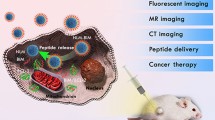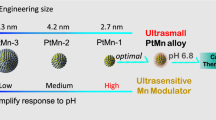Abstract
Theranostic nanodrugs combining magnetic resonance imaging (MRI) and cancer therapy have attracted extensive interest in cancer diagnosis and treatment. Herein, a manganese (Mn)-doped mesoporous polydopamine (Mn-MPDA) nanodrug incorporating the nitric oxide (NO) prodrug BNN6 and immune agonist R848 was developed. The nanodrug responded to the H+ and glutathione being enriched in tumor microenvironment to release R848 and Mn2+. The abundant Mn2+ produced through a Fenton-like reaction enabled a highly sensitive T1–T2 dual-mode MRI for monitoring the tumor accumulation process of the nanodrug, based on which an MRI-guided laser irradiation was achieved to trigger the NO gas therapy. Meanwhile, R848 induced the re-polarization of tumor-promoting M2-like macrophage to a tumoricidal M1 phenotype. Consequently, a potent synergistic antitumor effect was realized in mice bearing subcutaneous 4T1 breast cancer, which manifested the great promise of this multifunctional nanoplatform in cancer treatment.

Similar content being viewed by others
References
Zhou, Z. J.; Bai, R. L.; Munasinghe, J.; Shen, Z. Y.; Nie, L. M.; Chen, X. Y. T1-T2 dual-modal magnetic resonance imaging: From molecular basis to contrast agents. ACS Nano 2017, 11, 5227–5232.
Glunde, K.; Artemov, D.; Penet, M. F.; Jacobs, M. A.; Bhujwalla, Z. M. Magnetic resonance spectroscopy in metabolic and molecular imaging and diagnosis of cancer. Chem. Rev. 2010, 110, 3043–3059.
Zhou, Z. J.; Yang, L. J.; Gao, J. H.; Chen, X. Y. Structure-relaxivity relationships of magnetic nanoparticles for magnetic resonance imaging. Adv. Mater. 2019, 31, e1804567.
Yang, M. D.; Ho, C. H.; Ruta, S.; Chantrell, R.; Krycka, K.; Hovorka, O.; Chen, F. R.; Lai, P. S.; Lai, C. H. Magnetic interaction of multifunctional core—shell nanoparticles for highly effective theranostics. Adv. Mater. 2018, 30, e1802444.
Pablico-Lansigan, M. H.; Situ, S. F.; Samia, A. C. Magnetic particle imaging: Advancements and perspectives for real-time in vivo monitoring and image-guided therapy. Nanoscale 2013, 5, 4040–4055.
Zhou, Z. J.; Huang, D. T.; Bao, J. F.; Chen, Q. L.; Liu, G.; Chen, Z.; Chen, X. Y.; Gao, J. H. A synergistically enhanced T1-T2 dual-modal contrast agent. Adv. Mater. 2012, 24, 6223–6228.
Bhooshan, N.; Giger, M.; Lan, L.; Li, H.; Marquez, A.; Shimauchi, A.; Newstead, G. M. Combined use of T2-weighted MRI and T1-weighted dynamic contrast-enhanced MRI in the automated analysis of breast lesions. Magn. Reson. Med. 2011, 66, 555–564.
Gong, H.; Dong, Z. L.; Liu, Y. M.; Yin, S. N.; Cheng, L.; Xi, W. Y.; Xiang, J.; Liu, K.; Li, Y. G.; Liu, Z. Engineering of multifunctional nano-micelles for combined photothermal and photodynamic therapy under the guidance of multimodal imaging. Adv. Funct. Mater. 2014, 24, 6492–6502.
Krogsgaard, M.; Behrens, M. A.; Pedersen, J. S.; Birkedal, H. Self-healing mussel-inspired multi-pH-responsive hydrogels. Biomacromolecules 2013, 14, 297–301.
Guo, L. Q.; Liu, Q.; Li, G. L.; Shi, J. B.; Liu, J. Y.; Wang, T.; Jiang, G. B. A mussel-inspired polydopamine coating as a versatile platform for the in situ synthesis of graphene-based nanocomposites. Nanoscale 2012, 4, 5864–5867.
Wu, D.; Duan, X. H.; Guan, Q. Q.; Liu, J.; Yang, X.; Zhang, F.; Huang, P.; Shen, J.; Shuai, X. T.; Cao, Z. Mesoporous polydopamine carrying manganese carbonyl responds to tumor microenvironment for multimodal imaging-guided cancer therapy. Adv. Funct. Mater. 2019, 29, 1900095.
Chen, L. C.; Zhou, S. F.; Su, L. C.; Song, J. B. Gas-mediated cancer bioimaging and therapy. ACS Nano 2019, 13, 10887–10917.
Xu, W. M.; Liu, L. Z.; Loizidou, M.; Ahmed, M.; Charles, I. G. The role of nitric oxide in cancer. Cell Res. 2002, 12, 311–320.
Khan, F. H.; Dervan, E.; Bhattacharyya, D. D.; McAuliffe, J. D.; Miranda, K. M.; Glynn, S. A. The role of nitric oxide in cancer: Master regulator or not? Int. J. Mol. Sci. 2020, 21, 9393.
Xu, J. S.; Zeng, F.; Wu, H.; Hu, C. P.; Yu, C. M.; Wu, S. Z. Preparation of a mitochondria-targeted and no-releasing nanoplatform and its enhanced pro-apoptotic effect on cancer cells. Small 2014, 10, 3750–3760.
Lee, J.; Hlaing, S. P.; Hasan, N.; Kwak, D.; Kim, H.; Cao, J. F.; Yoon, I. S.; Yun, H.; Jung, Y.; Yoo, J. W. Tumor-penetrable nitric oxide-releasing nanoparticles potentiate local antimelanoma therapy. ACS Appl. Mater. Interfaces 2021, 13, 30383–30396.
Szabo, C. Gasotransmitters in cancer: From pathophysiology to experimental therapy. Nat. Rev. Drug Discov. 2016, 15, 185–203.
Dou, Y.; Zhao, F. S.; Li, X.; Guo, Y. Y. Monitoring nitric oxide-induced hypoxic tumor radiosensitization by radiation-activated nanoagents under BOLD/DWI imaging. ACS Biomater. Sci. Eng. 2021, 7, 5242–5254.
Paul, S.; Pan, S.; Mukherjee, A.; De, P. Nitric oxide releasing delivery platforms: Design, detection, biomedical applications, and future possibilities. Mol. Pharm. 2021, 18, 3181–3205.
Li, S. H.; Liu, R.; Jiang, X. X.; Qiu, Y.; Song, X. R.; Huang, G. M.; Fu, N. Y.; Lin, L. S.; Song, J. B.; Chen, X. Y. et al. Near-infrared light-triggered sulfur dioxide gas therapy of cancer. ACS Nano 2019, 13, 2103–2113.
He, Q. J. Precision gas therapy using intelligent nanomedicine. Biomater. Sci. 2017, 5, 2226–2230.
Fan, J.; He, N. Y.; He, Q. J.; Liu, Y.; Ma, Y.; Fu, X.; Liu, Y. J.; Huang, P.; Chen, X. Y. A novel self-assembled sandwich nanomedicine for NIR-responsive release of NO. Nanoscale 2015, 7, 20055–20062.
Deng, Y. Y.; Jia, F.; Chen, S. Y.; Shen, Z. D.; Jin, Q.; Fu, G. S.; Ji, J. Nitric oxide as an all-rounder for enhanced photodynamic therapy: Hypoxia relief, glutathione depletion and reactive nitrogen species generation. Biomaterials 2018, 187, 55–65.
Binnewies, M.; Roberts, E. W.; Kersten, K.; Chan, V.; Fearon, D. F.; Merad, M.; Coussens, L. M.; Gabrilovich, D. I.; Ostrand-Rosenberg, S.; Hedrick, C. C. et al. Understanding the tumor immune microenvironment (TIME) for effective therapy. Nat. Med. 2018, 24, 541–550.
Xiao, H.; Guo, Y.; Li, B.; Li, X. X.; Wang, Y.; Han, S. S.; Cheng, D.; Shuai, X. T. M2-like tumor-associated macrophage-targeted codelivery of STAT6 inhibitor and IKKβ siRNA induces M2-to-M1 repolarization for cancer immunotherapy with low immune side effects. ACS Cent. Sci. 2020, 6, 1208–1222.
Tang, X. Q.; Mo, C. F.; Wang, Y. S.; Wei, D. D.; Xiao, H. Y. Anti-tumour strategies aiming to target tumour-associated macrophages. Immunology 2013, 138, 93–104.
DeNardo, D. G.; Ruffell, B. Macrophages as regulators of tumour immunity and immunotherapy. Nat. Rev. Immunol. 2019, 19, 369–382.
Nadeem, A.; Siddiqui, N.; Al-Harbi, N. O.; Al-Harbi, M. M.; Ahmad, S. F. TLR-7 agonist attenuates airway reactivity and inflammation through Nrf2-mediated antioxidant protection in a murine model of allergic asthma. Int. J. Biochem. Cell Biol. 2016, 73, 53–62.
Hemmi, H.; Kaisho, T.; Takeuchi, O.; Sato, S.; Sanjo, H.; Hoshino, K.; Horiuchi, T.; Tomizawa, H.; Takeda, K.; Akira, S. Small antiviral compounds activate immune cells via the TLR7 MyD88-dependent signaling pathway. Nat. Immunol. 2002, 3, 196–200.
Lee, M.; Park, C. S.; Lee, Y. R.; Im, S. A.; Song, S.; Lee, C. K. Resiquimod, a TLR7/8 agonist, promotes differentiation of myeloid-derived suppressor cells into macrophages and dendritic cells. Arch. Pharm. Res. 2014, 37, 1234–1240.
Loré, K.; Betts, M. R.; Brenchley, J. M.; Kuruppu, J.; Khojasteh, S.; Perfetto, S.; Roederer, M.; Seder, R. A.; Koup, R. A. Toll-like receptor ligands modulate dendritic cells to augment cytomegalovirus- and HIV-1-specific T cell responses. J. Immunol. 2003, 171, 4320–4328.
Wang, Y. K.; Liu, Y.; Wu, H. X.; Zhang, J. P.; Tian, Q. W.; Yang, S. P. Functionalized holmium-doped hollow silica nanospheres for combined sonodynamic and hypoxia-activated therapy. Adv. Funct. Mater. 2019, 29, 1805764.
Hao, Y. N.; Zheng, A. Q.; Guo, T. T.; Shu, Y.; Wang, J. H.; Johnson, O.; Chen, W. Glutathione triggered degradation of polydopamine to facilitate controlled drug release for synergic combinational cancer treatment. J. Mater. Chem. B 2019, 7, 6742–6750.
Ma, Z. W.; Xiang, X. Q.; Li, S. Y.; Xie, P.; Gong, Q.; Goh, B. C.; Wang, L. Z. Targeting hypoxia-inducible factor-1, for cancer treatment: Recent advances in developing small-molecule inhibitors from natural compounds. Semin. Cancer Biol. 2022, 80, 379–390.
Sung, Y. C.; Jin, P. R.; Chu, L. A.; Hsu, F. F.; Wang, M. R.; Chang, C. C.; Chiou, S. J.; Qiu, J. T.; Gao, D. Y.; Lin, C. C. et al. Delivery of nitric oxide with a nanocarrier promotes tumour vessel normalization and potentiates anti-cancer therapies. Nat. Nanotechnol. 2019, 14, 1160–1169.
Ridnour, L. A.; Isenberg, J. S.; Espey, M. G.; Thomas, D. D.; Roberts, D. D.; Wink, D. A. Nitric oxide regulates angiogenesis through a functional switch involving thrombospondin-1. Proc. Natl. Acad. Sci. USA 2005, 102, 13147–13152.
Acknowledgements
This work was supported by the National Natural Science Foundation of China (Nos. 51933011 and 31971296), the Key Areas Research and Development Program of Guangzhou (No. 202007020006), Guangdong Basic and Applied Basic Research Foundation (No. 2020A1515010523), Guangzhou Science and Technology Bureau (No. 202102010181), and Guangdong Provincial Key Laboratory of Sensing Technology and Biomedical Instrument (Sun Yat-sen University, No. 2020B1212060077).
The animal study protocol was approved by the Institutional Animal Care and Use Committee at Sun Yat-sen University (SYSU-IACUC-2021-000225).
Author information
Authors and Affiliations
Corresponding authors
Electronic Supplementary Material
Rights and permissions
About this article
Cite this article
Hou, X., Yang, X., Xu, Y. et al. Manganese-doped mesoporous polydopamine nanoagent for T1–T2 magnetic resonance imaging and tumor therapy. Nano Res. 16, 2991–3003 (2023). https://doi.org/10.1007/s12274-022-4877-4
Received:
Revised:
Accepted:
Published:
Issue Date:
DOI: https://doi.org/10.1007/s12274-022-4877-4




